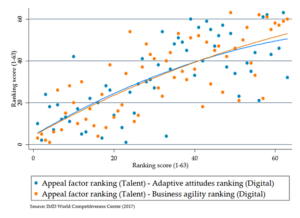
Is the flow of skilled labor related to the agility of an economy?
Reflecting on the popular topics for 2017, two themes stand out among those which captured the interest of researchers and commentators. First, the extent to which economies successfully address the future loss of employment due to the introduction of new technologies; and second, the benefits associated with the general concept of globalization.
In the past editions of this newsletter, we addressed dimensions of both topics separately. The newly launched 2017 IMD World Talent Ranking gives us the opportunity to combine them. In this edition, we will try to explore how the IMD World Competitiveness Dataset can help us relate the attractiveness of an economy to the international pool of talent and the levels of individual adaptive attitudes and business agility.
Attitudes towards changes, both at the individual and at the firm level, affect the adaptation of innovation. At the individual level, the ease by which one can adapt to new environments and become accustomed to new technologies provides an indication of the capacity to successfully adapt to changes within professions. The Adaptive Attitudes sub-factor of the IMD Digital Competitiveness Ranking quantifies this ability.
Similarly, the flexibility and resilience that a firm exhibits towards disruptive changes brought about by new technology and thus the competence to adapt at a business level is reflected in the Business Agility sub-factor of the same ranking.
Within our dataset the level of openness of an economy can be quantified by using either statistical data (e.g. trade to GDP ratio) or survey data (e.g. the perceptions data of managers about the level of protectionism in an economy). An additional way to indirectly measure openness with respect to labor movements is the power of an economy to attract skilled people from the international talent pool. This is captured by the Appeal factor of the IMD World Talent Ranking. Elements related to the quality and cost of living, remuneration and levels of taxation, as well as security and protection of private rights are combined to provide a measure of the Appeal Factor.
The graph below presents the positive relationship between the level of appeal and measures of flexibility both at the individual and business levels. An economy that is characterized by high levels of attractiveness (Appeal) is related to equally high levels of individual adaptability (AdaptiveAttitudes) The correlation coefficient of 0.73 validates this strong positive relationship (the blue line.)
Similarly, the correlation coefficient of 0.77 between the Appeal factor and the Business Agility sub-factor indicated that highly-skilled labor inflow is strongly related with the ability of a firm to cope with technology disruptions (the orange line).
Additional research is needed to carefully examine the causation of this relationship. Nevertheless, this simple graph invites an interesting narrative: highly-skilled migrants bring with them an enhanced level of adaptation and flexibility; or they rapidly integrate into the existent high level of adaptation in their host economy. Furthermore, this enhanced level of flexibility potentially spills over to the aggregate unit of the firm itself. Thus, highly-skilled migrants are also associated with high levels of Business Agility. In sum, flows of highly-skilled labor strengthen an economy by contributing, amongst other things, to a higher degree of flexibility and resilience.
Research Information & Knowledge Hub for additional information on IMD publications
The GreenGro (A) case explores the challenges faced by GreenGro, a mid-sized agricultural technology company, as it navigates a rapidly changing industry landscape. CEO Sarah Chen and her leadership team are confronting issues ranging from technol...
The GreenGro (B) case study is a follow-up to GreenGro (A) and details how the company applied the TSUNAMI and SURF frameworks to address its complex challenges. The case illustrates the practical implementation of these frameworks, introduced in ...
In June 2024, at the CocoaCrafters Operating Centre, Elena Fever faced a crucial meeting with the board of directors. The discussion surrounded how to integrate Generative AI (GenAI) into the company’s supply chain strategy to enhance forecasting ...
When the dotcom bubble burst in March 2000, this did not stop the world from going digital, but it did poke holes in the concept of trust, especially in the digital world. David Goldenberg, a Belgian entrepreneur with extensive experience in manag...
China has set a bold objective to become the global leader in AI by 2030. By 2030, AI could potentially add $600 billion to China's economy annually. The country hosted over 4,500 AI companies in 2024, representing 15% of the global total. China i...
in I by IMD
Research Information & Knowledge Hub for additional information on IMD publications
Research Information & Knowledge Hub for additional information on IMD publications
The GreenGro (B) case study is a follow-up to GreenGro (A) and details how the company applied the TSUNAMI and SURF frameworks to address its complex challenges. The case illustrates the practical implementation of these frameworks, introduced in ...
Research Information & Knowledge Hub for additional information on IMD publications
The GreenGro (A) case explores the challenges faced by GreenGro, a mid-sized agricultural technology company, as it navigates a rapidly changing industry landscape. CEO Sarah Chen and her leadership team are confronting issues ranging from technol...
Research Information & Knowledge Hub for additional information on IMD publications
Case reference: IMD-7-2593 ©2024
Research Information & Knowledge Hub for additional information on IMD publications
Case reference: IMD-7-2611 ©2024
Research Information & Knowledge Hub for additional information on IMD publications
in I by IMD 8 January 2025
Research Information & Knowledge Hub for additional information on IMD publications
in I by IMD
Research Information & Knowledge Hub for additional information on IMD publications
Research Information & Knowledge Hub for additional information on IMD publications
Research Information & Knowledge Hub for additional information on IMD publications





